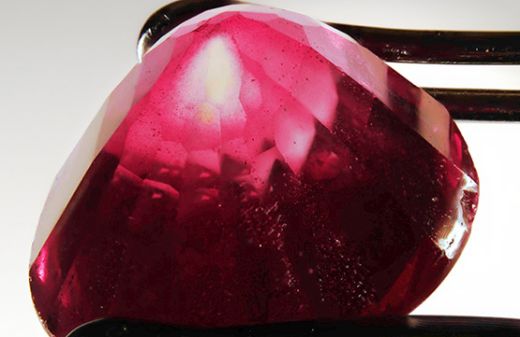
Synthetic Ruby Overgrowth Discovered at GIA
23.04.18
In recent months, at its’ New York laboratory, the Gemmological institute of America (GIA) received two oval mixed cut red stones. Upon further inspection and testing they turned out to be natural sapphires with a synthetic ruby covering – an “overgrowth” which tinted the entire gem red.
To the naked eye, a strong concentration of reddishness at the facet junctions appears to come from a treatment called chromium diffusion. This process adds chromium, the element that gives ruby its’ red colour, which enhances the natural redness. The presence of the overgrowth was revealed under a microscope and showed the host stone was a natural, almost colourless, sapphire.

This photo shows one of the wafers prepared for LA-ICP-MS analysis in transmitted (left) and darkfield lighting (right). The Thickness of the synthetic ruby overgrowth and the inclusions in the natural seed are readily visible. Photos J. Muyal © GIA.
The visual characteristics of the stones mimicked those of a technique called “Lechleitner”, in which a synthetic emerald overgrowth adds greenness to a near-colourless beryl. In the 1960’s Johann Lechleitner experimented with both emerald and ruby overgrowths. The stones the GIA received however are suspected of using a different growth mechanism, as Lechleitner’s rubies contained molybdenum, yet the New York stones contained platinum.
This process is not new and is not the first time it’s been reported, it is however, the first time one of these stones has been submitted for identification at the GIA laboratory.
What does this mean for the gem trade? As gemstones are highly prized possessions, which often come with the price tag to prove, there is no signs of lab-grown synthetic gem production slowing down. However, a natural high quality gemstone will always be a cut above the rest when it comes to jewellery, and labs know how to spot a red herring when one passes through their microscopes!




